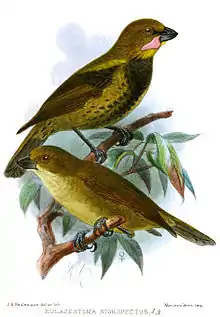Wattled ploughbill
The wattled ploughbill (Eulacestoma nigropectus) is a small bird from New Guinea. It is the only member of the monotypic genus Eulacestoma and family Eulacestomidae.
| Wattled ploughbill | |
|---|---|
 | |
| Scientific classification | |
| Kingdom: | Animalia |
| Phylum: | Chordata |
| Class: | Aves |
| Order: | Passeriformes |
| Suborder: | Passeri |
| Family: | Eulacestomidae Schodde & Christidis, 2014 |
| Genus: | Eulacestoma De Vis, 1894 |
| Species: | E. nigropectus |
| Binomial name | |
| Eulacestoma nigropectus De Vis, 1894 | |
Taxonomy
The wattled ploughbill was long thought to be related to the whistlers (Pachycephalidae), and shriketits (formerly Pachycephalidae, now often treated as its own family). In particular the wattled ploughbill and crested shriketit share a similar large bill. Genetic studies have shown that these birds are not closely related, and as instead more closely related to the sittellas. Because of its genetic and morphological uniqueness, in 2014 Richard Schodde and Leslie Christidis placed it in its own monotypic family Eulacestomidae. [2]
The wattled ploughbill is a monotypic species, meaning it has no accepted subspecies. A subspecies clara has been proposed, but it is not reliably distinct from other birds in this species.[3]
Description
It is approximately 12.5 to 14 cm (4.9–5.5 in) , olive-brown songbird with a strong, thick, wedge-shaped black bill. It weighs 19–22 g (0.67–0.78 oz). The sexes are different. The male has black underparts, an almost golden forehead, black wings with golden scapulars, and a pair of large circular pink wattles on the cheek. The female has olive green plumage and pale olive below. Only the adult male has wattles.[3]
Distribution and habitat
The wattled ploughbill is distributed and endemic to central mountain ranges of New Guinea.
Behaviour
The diet consists mainly of insects. The species feeds from the forest floor to up to 10 m (33 ft), from the understory to the mid-level of the forest. It particularly favours groves of bamboo as a micro-habitat for feeding. It forages on branches and twigs, gleaning insects from the surface and prising off bark to expose prey. The species will readily join mixed-species feeding flocks.[3]
Conservation
Widespread throughout its large range, the wattled ploughbill is evaluated as least concern on the IUCN Red List of Threatened Species.
References
- BirdLife International (2012). "Eulacestoma nigropectus". IUCN Red List of Threatened Species. 2012. Retrieved 26 November 2013.CS1 maint: ref=harv (link)
- Schodde, R.; Christidis, L. (2014). "Relicts from Tertiary Australasia: undescribed families and subfamilies of songbirds (Passeriformes) and their zoogeographic signal". Zootaxa. 3786 (5): 501–522.
- Boles, W (2018). del Hoyo, Josep; Elliott, Andrew; Sargatal, Jordi; Christie, David A; de Juana, Eduardo (eds.). "Wattled Ploughbill (Eulacestoma nigropectus)". Handbook of the Birds of the World Alive. Barcelona: Lynx Edicions. Retrieved 13 February 2019.
- del Hoyo, J.; Elliot, A. & Christie D. (editors). (2007). Handbook of the Birds of the World. Volume 12: Picathartes to Tits and Chickadees. Lynx Edicions. ISBN 978-84-96553-42-2
